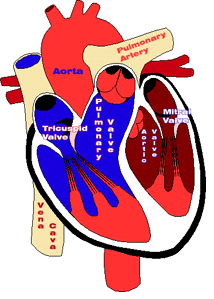- Heart
- The Heart
- Coronary Artery Disease
- Heart Attack
- Heart Valve Disease
- Atrial Fibrillation
- Atrial Flutter
- Vascular
- Peripheral Vascular Disease
- Abdominal Aortic Aneurysms
- Lung
- Lung Cancer
- Genearl Info
- Diabetes
- Video Library
- My Heart Notebook
- Glossary
 What are
Heart Valves?
What are
Heart Valves?
Your heart has four valves. Each valve is made of thin tissue flaps called leaflets that open and close to regulate blood flow between the four chambers of your heart. They open in one direction to allow forward blood flow and close to prevent backward blood flow. If these valves do not work properly, the heart will not work effectively.
Two of the valves are located on the right side of your heart where oxygen-poor blood comes in from the body. They are called the Pulmonary valve and the Tricuspid valve. The other two are located on the left side of your heart where oxygen-rich blood comes in from your lungs to be pumped out to your body. These are called the Mitral valve and the Aortic valve.
Heart Valve Problems
Valve disease occurs when a valve doesn't work the way it should. If a valve doesn't open all the way, less blood can move through the smaller opening. If a valve doesn't close tightly, blood may leak backward. These problems may mean the heart has to work harder to pump the same amount of blood. Or blood may back up in the lungs or body because it's not moving efficiently through the heart.
 Problems Opening: Stenosis occurs when a valve doesn't open completely. The valve may have become hardened or stiff with calcium deposits or scarring, so it's hard to push open. Blood has to flow through a smaller opening, so less blood gets through the valve into the next chamber.
Problems Opening: Stenosis occurs when a valve doesn't open completely. The valve may have become hardened or stiff with calcium deposits or scarring, so it's hard to push open. Blood has to flow through a smaller opening, so less blood gets through the valve into the next chamber.
 Problems Closing:
Insufficiency (also called regurgitation) results when the valve doesn't close tightly. The valve's supportive structures may be loose or torn. Or the valve itself may have stretched or thinned. Blood then may leak back in the wrong direction through the valve.
Problems Closing:
Insufficiency (also called regurgitation) results when the valve doesn't close tightly. The valve's supportive structures may be loose or torn. Or the valve itself may have stretched or thinned. Blood then may leak back in the wrong direction through the valve.